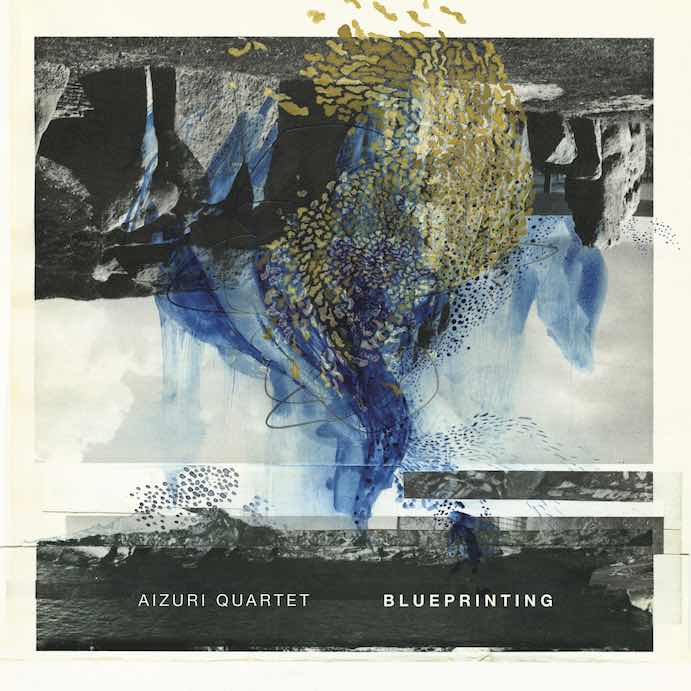This review could be very short:
Aizuri Quartet’s debut album Blueprinting is brilliant.
Purchase it now and listen to it often.
It really is just that simple.
Released September 29 on New Amsterdam Records, Blueprinting showcases Aizuri Quartet as a moving, technically facile, and musically sweeping ensemble. The five works on this album not only draw interest on their own, but as a collection speak to the larger ideas of growth, collaboration, and community. The music and performance is, in a word, stunning.
Aizuri Quartet, founded in 2012, is named for “aizuri-e,” a detailed style of Japanese woodblock printing that is predominantly blue in color, another poetic tie-in with the album’s name and concept of Blueprinting. Made up of Ariana Kim and Miho Saegusa (violins); Ayane Kozasa (viola); and Karen Ouzounian (cello), the quartet has won numerous prestigious chamber music awards, and they are “passionate about creating diverse points of entry into the string quartet repertoire.”

Aizuri Quartet–Photo by Shervin Lainez
This new album (their debut), features five newly commissioned works. According to the group, the album’s title, Blueprinting, “implies building a project that takes time and requires significant planning.” Aizuri takes time to point out that they have lived with these pieces through a long process of workshopping, rehearsing, performing, and touring — and the results, heard on this album, are of the highest caliber.
The opening track, Carrot Revolution by Gabriella Smith, was inspired in part by a (perhaps mis-attributed) Paul Cezanne quote: “The day will come when a single, freshly observed carrot will inspire a revolution.” The piece intends to look at the old genre of the string quartet and the even older styles which inform Smith’s writing with fresh eyes. The results are indeed fresh, opening with invigorating extended techniques in syncopated rhythms and continuing to romp through a series of otherworldly yet somehow familiar soundscapes–at one point, a more “traditional” string quartet sound palette does come through, only to acoustically deteriorate and melt away. The quartet imbues every glissando and ostinato with enthusiasm and emotion in this very effective piece.
Caroline Shaw’s Blueprint draws inspiration both from the quartet’s namesake of aizur-e and from architectural blueprints, literally generating from a harmonic reduction of Beethoven’s String Quartet Op. 18 No. 6 as its “foundation” and building an architectural “conversation” between Beethoven, Haydn (his teacher), the string quartet members, and the composer herself. Immersing the listener in both nostalgia and curiosity all at once, Blueprints feels intimately like a journey down memory lane for any lover of string quartet music. I particularly enjoyed the loving approach to tone color employed by the quartet in this performance; they take time to draw out the nuances of every timbre.

Caroline Shaw
Continuing in the architectural realm, RIPEFG stands as a two-movement musical monument to the life of one of the composer Yegeniy Sharlat’s dearest friends and former students, Ethan Frederick Greene. Sharlat spent months listening to Greene’s music as a part of the mourning process, and the result was a shift in perspective and style. Most prominently, Sharlat’s piece features the melodica, an instrument often carried by his former student. In the first movement, the inclusion of the reedy timbre of this instrument amongst frantic melodies and a disjunct minor tonality creates an air of desperation. This tension is not resolved by the second movement, but instead morphs into a feeling of suffocation, with the violin’s pizzicato melody strung out over the backdrop of what sound at first like raindrops, but are more likely bits of falling ash from the apocalypse outside the window. Once again in this piece, Aizuri Quartet plays with an astonishing range of expression, and even the melodica integrates, not a “new music-y” novelty but a deeply beautiful component of the mournful tapestry.
Next on the album is a two-movement collection of instrumental scenes excerpted from Lembit Beecher’s chamber opera Sophia’s Forest. Titled Sophia’s Wide Awake Dreams, the piece features an eerie music box and nine sound sculptures built by the composer for the opera premiere, which generate sound acoustically from bike wheels and wine glasses. The use of the sound sculptures both within the opera and this piece depicts the inner world of a nine-year-old girl who comes to the United States with her mother after her father is lost in a civil war. Beecher is known for unconventional interdisciplinary works as well as deeply emotional music, and the performance here is no exception. The string players carry the listener through stark juxtapositions of passionate frenzy and innocent wonder–the nearly indistinguishable blend between wine glasses and violins is particularly astounding.

Paul Wiancko
Concluding the album with LIFT, a three-part composition by Paul Wiancko, we come full circle back to the playfulness syncopations and open harmonies found in the opening track–but where Carrot Revolution delighted in the earthy crunch of some extended techniques and tight dissonances, Wiancko says that LIFT “joyously explores the capacity for harmony, color, and rhythm itself to evoke and inspire.” Each of the three parts contains multiple sections, creating in total a sort of treatise on possible sounds to be found in a–very decidedly–21st century string quartet.
Aizuri Quartet’s recording debut immediately places them at the forefront of string quartets working in the contemporary idiom. Their ability to function as a perfectly unified ensemble while exploring every nook and cranny of a piece’s soundworld makes literally every moment of Blueprinting completely satisfying.




















